8+ Sample Brand Strategic Plan
-

Brand Management Strategic Teaching Plan
download now -

Brand Building Strategic Plan
download now -
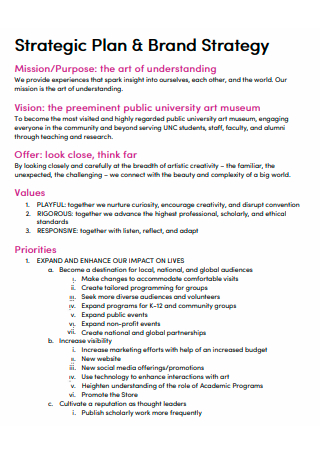
Brand Strategic Plan Example
download now -
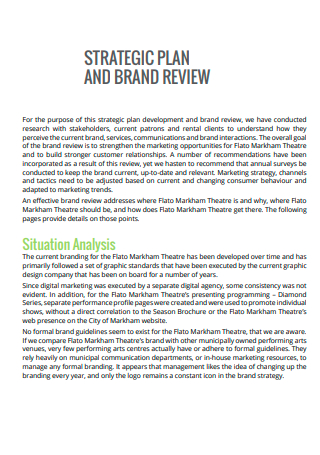
Brand Review Strategic Plan
download now -

Brand Strategic Plan in PDF
download now -
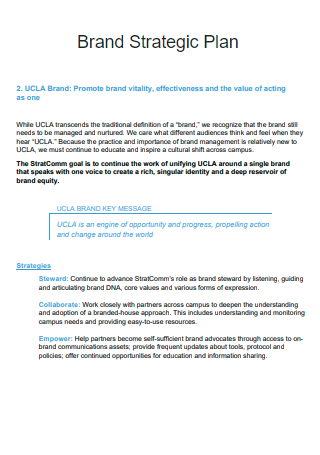
Printable Brand Strategic Plan
download now -
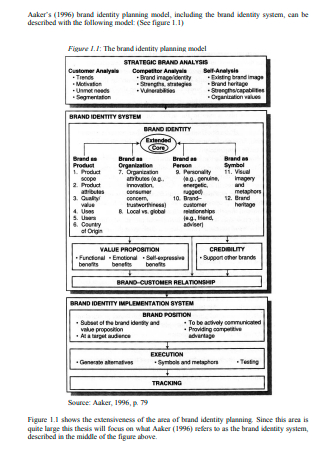
Brand Analysis Strategic Planning
download now -

Brand Strategic Marketing Plan
download now -
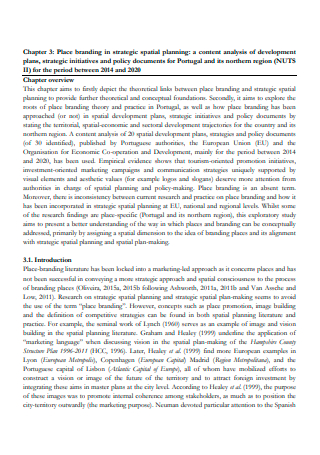
Standard Brand Strategic Plan
download now
FREE Brand Strategic Plan s to Download
8+ Sample Brand Strategic Plan
What is a Brand Strategic Plan?
Different Types of Brand Strategic Plans
Basic Components of a Brand Strategic Plan
How to Write a Brand Strategic Plan
FAQs
What are the basic components of a brand strategic plan?
What are some examples of brand strategic plans?
What is the importance of brands to society?
What are the major branding strategies?
What is a Brand Strategic Plan?
A brand strategic plan is a comprehensive, integrated action plan that guides brand managers and project leaders to acquire an understanding of the business strategy of a company or organization and translating it into the brand expression . This strategic plan is an effective brand management tool which helps brands to ease consumer decision making, minimize consumer risk, and provide emotional satisfaction for both consumers and brand developers. In order to achieve further brand development and success, brand managers and project leaders should develop and implement strategic plans.
A Label Insight report has shown that 39% of consumers would start using a brand if it offered full product transparency. People are significantly more loyal to brands that are transparent about various aspects of their business based on a consumer behavior study conducted to 2,000 respondents. For example, consumers value companies that are honest about the ingredients they use especially when it comes to food and personal care products. Thus, all kinds of brand managers, brand developers, project supervisors, content marketing strategists, and business owners should effectively create a well-detailed and coordinated brand strategic plan.
Different Types of Brand Strategic Plans
Marty Neumeier, author, speaker, and current director of CEO Branding at branding agency Liquid Agency, said: “Branding is the process of connecting good strategy with good creativity.” He explained in his book The Brand Flip that brands need to flow through multiple technologies because the most successful brands are not static, but fluid or flexible. Brand managers and content marketers are fully invested in customer experience as their goal is to enhance the experience and highlight the meaning of their new, current and future products. If you are one of the members of a brand development team, you should be well-informed about the different types of brand strategic plans that you will use for your business or organization matters. Here we will explain to you about the different types of brand strategic plans below:
1. Collaborative or Joint Partnership Brand Strategic Plan
Also known as co-branding, collaborative or joint partnership is a type of strategic marketing and advertising partnership that exists between two brands wherein the success of one brand brings success to its partner band as well. Creating a brand strategic plan for a collaborative or joint partnership is an effective method in building business, boosting awareness and breaking into new markets. There are some notable examples of successful joint partnerships out there. One of them is when Starbucks and Spotify forged a unique co-branding partnership to develop a “music ecosystem” which will provide artists greater access to Starbucks consumers and giving Starbucks access to the extensive discography of Spotify. With this, Starbucks employees receive a Spotify premium subscription which they can utilize in curating playlists to play throughout the day in the shop. This state-of-the-art initiative is designed to expand the coffeehouse environment that Starbucks is known for while increasing the exposure of artists to Starbucks consumers.
2. Visual Arts and Design Brand Review Strategic Plan
Due to the pandemic, it had an immense impact on visual arts and design brands especially in their visual content marketing. Content marketers need to get creative to keep audience engagement. Most of them had to change their visual marketing strategy. Thus, preparing a systematic health design strategic plan is useful in improving eclectic health care and other medical services. A study report showed that almost 41% of respondents said infographics and illustrations are the most effective strategies for achieving their goals. Videos and presentations (23.7%) are also used along with charts and data visualizations (15.4%). Creating a ton of innovative content that your audience wants is a challenging and tough work to do because it takes a lot of time and energy. Preparing a brand review strategic plan can help brand managers and visual content marketers to determine what has been working, what has not, and what specific opportunities that they might actually be missing out on that could potentially move their arts and design business forward. Collect and organize all the brand materials to review on such as logo, icons, textures or design accents, typography, and color scheme (branding), messaging and tone, page titles, and blog headlines (content), and packaging, business cards, letterhead and envelopes (marketing), etc. Examine them and carefully develop your brand review strategic plan.
3. Fashion, Lifestyle and Culture Magazine Brand Analysis Strategic Plan
Vogue, Elle, Cosmopolitan, W, InStyle, Allure, V, and Marie Claire are some examples of well-known fashion, lifestyle and culture magazine brands worldwide. If you are a brand manager or content marketer of a media publishing firm that owns a new fashion and lifestyle magazine brand, writing a brand analysis strategic plan is an essential method to evaluate your company’s branding strategies and methods concerning your new fashion and lifestyle magazine brand. It is a set of steps and strategies that you can use to assess the current branding strategies of your media publishing firm as you find your marketing strengths and pinpoint areas of improvement. Some common elements that you need in your brand analysis strategic plan are branding goals, objectives, objective results, internal feedback, customer feedback, competitive analysis, market analysis, and new branding strategies. So, you need to conduct a survey or plan a meeting with your magazine staff members and ask them how they perceive the brand. Gather customer feedback, design your brand analysis, evaluate your market competition, document your findings and formulate new branding strategies for the brand.
4. Food, Health, and Wellness Brand Strategic Marketing Plan
There is a growing consumer interest in health food supplements, meditation, skin care products and self care during these pandemic times. This is an enormous opportunity for entrepreneurs to venture into the food, health and wellness field. If you are currently managing a new food, health and wellness brand, making a brand strategic marketing plan is a beneficial planning tool to help you in creating repeat buyers or in connecting with buyers who constantly make long-term, expensive purchases. You need to be more thorough in developing your brand marketing strategy so that you are able to increase the likelihood of thriving when you execute those strategies for your food, health and wellness brand.
Basic Components of a Brand Strategic Plan
In this section, you will learn how to construct a well-written and systematic brand strategic plan. However, a brand strategic plan has different kinds of components. Include the following elements for you to create a professional piece of writing:
How to Write a Brand Strategic Plan
“Branding reflects the reality of the core product, its facts and features, its functions and benefits as well as the surrounding aura of its aesthetic, its music, its texture, its visualization, and its fantasy-like existence in the culture as it relates to societal and customer mythology. Ultimately, a brand is an opus, a complex design, a mosaic, a symphony, an evolving cultural construction that benefits from a knowledgeable, and perspective director, and that fires the imagination. The most successful and iconic brands go beyond the ordinary elements, to become quintessential and transcendentally so.” This eloquent description of branding comes from Bastos and Levy (2012) as they emphasize the multifaceted nature of brands and branding, being explored from a combination of sociological, cultural, psychological, and managerial perspectives. Follow the steps indicate below on how to write a clear and structured brand strategic plan:
Step 1: Think Carefully on Your Business Strategy
What type of business or brand that you want to establish? What are the measurable goals and objectives of your brand? Are you planning to grow organically? Start with knowing your overall business or brand strategy so that you are able to know the things you need to accomplish in realizing the creation or development of your brand.
Step 2: Identify and Research Your Target Audience
Who are your target audience? It is very integral to define your target audience or consumers clearly as this will help your brand grow and expand faster. Conduct systematic and in-depth research on your target audience so that you and your brand strategic planning team can understand the perspective and priorities of your target audience, anticipate their needs and put your message in the language that resonates with them.
Step 3: Brand Positioning and Setting Visual Identity
When you position your brand, make sure that it matches the brand itself as it should be able to deliver the promise and it should be in line with the strengths of the brand to form and maintain consistency. It must be relevant and meaningful for the target audience. Also, the desired brand image should be distinctive or different from the image of competing brands. To be successful in your brand strategic plan, find a distinctive position for your brand. Then, set a unique visual identity of your brand by developing your brand name and tagline, and designing a compelling style, logo, etc. Give your brand a one-of-a-kind concept and personality, as well as values that are aligned in your company or organization.
Step 3: Develop Innovative Content Marketing Strategies
A 2020 statistical report revealed that 92% of marketers and companies said that content is their valuable business asset. To stabilize the strength of your brand reputation and visibility, it is crucial to increase your brand awareness through content marketing. This strategic marketing approach is focused on creating and distributing valuable, relevant, and consistent content to entice and retain a clearly defined audience and especially, to drive profitable customer action. It provides many benefits such as increased sales, cost savings, better loyal customers, and meaningful content.
Step 4: Build Your Marketing Toolkit
Include one-page sales sheets that describe the major services offerings or key markets served, and videos related to your brand and its products and services. List them down on your brand strategic plan.
Step 5: Proofread and Finalize the Overall Brand Strategic Plan
Review your entire brand strategic plan and make sure that you fully present all the fundamental points in your plan. If you realize that you overlook some sections that need more elements, it is important to edit and revise the document as soon as possible.
FAQs
What are the basic components of a brand strategic plan?
The basic components that should be included in a brand strategic plan are brand strategy overview, goals, objectives, and issues, target market research and analysis, brand positioning and visual identity, brand strategies and content marketing methods, and brand development monitoring and evaluation.
What are some examples of brand strategic plans?
Some examples of brand strategic plans are corporate brand management strategic teaching plan, architectural and engineering services brand building strategic plan, visual arts and design brand review strategic plan, fashion, lifestyle and culture magazine brand analysis strategic plan, food, health, and wellness brand strategic marketing plan, collaborative or joint partnership brand strategic plan, and many other brand strategic plans.
What is the importance of brands to society?
Brands greatly contribute to sustainable wealth creation, security and stability of employment in the counties in which they operate, bringing associated social benefits. They can reflect many societal values and ideologies, and reflect different characteristics of a person’s society and its dominant ideology. Through successful brands, they promote globalization in many areas across diverse countries.
What are the major branding strategies?
Line extension, brand extension, new brand strategy, and flanker/flight brand strategy are the major branding strategies. Line extension brand growth strategy is when you create additional products in response to consumer needs. Brand extension brand strategy is an introduction of a new brand in a new market after consolidating your brands’ name in a related field. New brand strategy is when a business firm establishes a new brand to go along with a new product. Flanker brand strategy is the placement of a new brand or sub-brand at the high or lower ends of the spectrum to attract new market segments.
Successfully branded products and services can command a premium price, enhance consumer loyalty, promote the introduction of new products and services, instantly register in the consumer’s mind with a brand symbol or logo, help extend a brand’s accumulated goodwill to a related product or service offering, and carry the essence of this goodwill as the business firm’s offerings change. It is essential to be skilled in writing a clear and coordinated brand strategic plan for your company or organization. To help you in effective brand strategic planning, you can learn and apply the tips aforementioned in this article. Plus, we have included several brand strategic plan layout templates to guide you including lifestyle and culture magazine brand analysis strategic plan, food, health, and wellness brand strategic marketing plan, collaborative or joint partnership brand strategic plan, and many other brand strategy roadmap templates that you can download easily and quickly!
